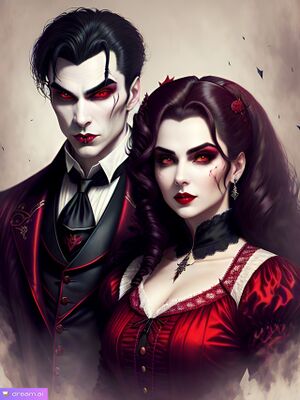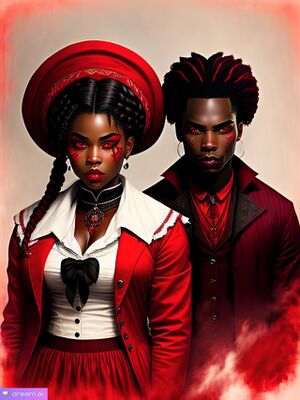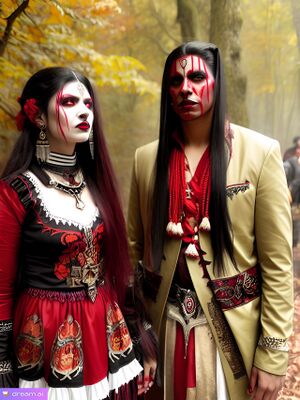No edit summary |
No edit summary |
||
| Line 5: | Line 5: | ||
[[File:Vampire-native-american.jpg|thumb|Image of modern Native American vampires.]] | [[File:Vampire-native-american.jpg|thumb|Image of modern Native American vampires.]] | ||
[[File:Vampire-american.jpg|thumb|Image of modern American vampires.]] | [[File:Vampire-american.jpg|thumb|Image of modern American vampires.]] | ||
Vampires, supernatural beings of the night, have been a part of human folklore for centuries, their stories whispered in hushed tones around the globe. These creatures, known for their pale skin and fangs, are said to sustain their immortality by feeding on the life essence, typically in the form of blood, of the living. Vampires are either humans transformed by the VX Virus or offspring of two vampires. Those turned retain much of their human personality for several decades after transformation, but over time, they often develop peculiarities and become more pragmatic. Vampires possess superior physical abilities and can use either magical or [[Psionic Energy|psionic energy]], powered by blood consumption. They are not affected by holy symbols, and can only be killed by burning or decapitation. Their bodies become stronger and more resilient after transformation, and they no longer need food, instead being sustained by blood. The process of turning a human into a vampire is complex and often brutal, and the newly turned vampire forms a strong bond with their creator. Vampires can mate and produce offspring, but the process is difficult and requires a lot of blood. Vampire society is hierarchical and complex, with older vampires holding significant influence. They often form groups known as clans or covens for protection and community, and they have their own set of laws and customs. | Vampires, supernatural beings of the night, have been a part of human folklore for centuries, their stories whispered in hushed tones around the globe. These creatures, known for their pale skin and fangs, are said to sustain their immortality by feeding on the life essence, typically in the form of blood, of the living. Vampires are either humans transformed by the VX Virus or offspring of two vampires. Those turned retain much of their human personality for several decades after transformation, but over time, they often develop peculiarities and become more pragmatic. Vampires possess superior physical abilities and can use either [[Magical Energy|magical]] or [[Psionic Energy|psionic energy]], powered by blood consumption. They are not affected by holy symbols, and can only be killed by burning or decapitation. Their bodies become stronger and more resilient after transformation, and they no longer need food, instead being sustained by blood. The process of turning a human into a vampire is complex and often brutal, and the newly turned vampire forms a strong bond with their creator. Vampires can mate and produce offspring, but the process is difficult and requires a lot of blood. Vampire society is hierarchical and complex, with older vampires holding significant influence. They often form groups known as clans or covens for protection and community, and they have their own set of laws and customs. | ||
== Personality == | == Personality == | ||
| Line 14: | Line 14: | ||
== Weaknesses == | == Weaknesses == | ||
Contrary to popular belief and religious rhetoric, holy water, crosses, or other symbols of faith have no impact on a vampire. | Contrary to popular belief and religious rhetoric, holy water, crosses, or other symbols of faith have no impact on a vampire. The only known ways to kill a vampire are through burning and decapitation. Modern scientific methods, such as anti-viral treatments, have been tested but have proven to be completely unsuccessful. This is likely due to the supernatural component of the VX Virus that infects vampires. The virus itself is preternatural, existing outside of our current understanding of natural biology. | ||
Attempts to medically restore a vampire to its human state or reduce its reliance on blood have all ended in failure, often resulting in a significant loss of human life. Even when the vampire is willing to undergo these procedures, which is rare, the outcomes are not successful. This suggests that the transformation into a vampire is not merely a physical ailment that can be cured or managed. Instead, it's akin to a metamorphosis, much like a caterpillar transforming into a butterfly, a process that cannot be reversed. | |||
== Strengths == | == Strengths == | ||
Revision as of 21:05, 22 July 2023






Vampires, supernatural beings of the night, have been a part of human folklore for centuries, their stories whispered in hushed tones around the globe. These creatures, known for their pale skin and fangs, are said to sustain their immortality by feeding on the life essence, typically in the form of blood, of the living. Vampires are either humans transformed by the VX Virus or offspring of two vampires. Those turned retain much of their human personality for several decades after transformation, but over time, they often develop peculiarities and become more pragmatic. Vampires possess superior physical abilities and can use either magical or psionic energy, powered by blood consumption. They are not affected by holy symbols, and can only be killed by burning or decapitation. Their bodies become stronger and more resilient after transformation, and they no longer need food, instead being sustained by blood. The process of turning a human into a vampire is complex and often brutal, and the newly turned vampire forms a strong bond with their creator. Vampires can mate and produce offspring, but the process is difficult and requires a lot of blood. Vampire society is hierarchical and complex, with older vampires holding significant influence. They often form groups known as clans or covens for protection and community, and they have their own set of laws and customs.
Personality
Vampires retain much of their human personality for the first several decades (about 30-50 years) after being turned. Over time, they tend to become more pragmatic and develop peculiarities, often manifesting as forms of insanity. The older a vampire, the more peculiar they can become, usually displaying neurotic, paranoid behaviors or developing odd obsessions. However, they are fundamentally pragmatic, with status being measured by the wealth, power, and comfort they can amass. They enjoy power most of all, particularly the power to compel humans to do their bidding of their own free will. Vampires are manipulative and patient, willing to wait for the right time, even if it takes decades or centuries. This does not prevent some vampires from becoming bored with the waiting game and thus willing to create the situation they require.
Abilities
All vampires possess superior strength, dexterity, speed, and durability. These abilities increase with age, and all vampires have one ability that increases faster than others, which is considered their specialty. They can also use either magical energy or psionic energy, but never both. These abilities are powered by blood, meaning vampires need to feed more often the more they use their abilities. A vampire's specialty uses less blood than a non-specialty. While it is referred to as if it is some kind of fuel, it should be noted that the blood needs to be consumed and digested to restore abilities or restore a vampire. This process happens quickly, but the body does not store excess blood; it simply consumes blood until it is full.
Weaknesses
Contrary to popular belief and religious rhetoric, holy water, crosses, or other symbols of faith have no impact on a vampire. The only known ways to kill a vampire are through burning and decapitation. Modern scientific methods, such as anti-viral treatments, have been tested but have proven to be completely unsuccessful. This is likely due to the supernatural component of the VX Virus that infects vampires. The virus itself is preternatural, existing outside of our current understanding of natural biology.
Attempts to medically restore a vampire to its human state or reduce its reliance on blood have all ended in failure, often resulting in a significant loss of human life. Even when the vampire is willing to undergo these procedures, which is rare, the outcomes are not successful. This suggests that the transformation into a vampire is not merely a physical ailment that can be cured or managed. Instead, it's akin to a metamorphosis, much like a caterpillar transforming into a butterfly, a process that cannot be reversed.
Strengths
When turned by the VX Virus, vampires no longer need food to sustain themselves. They have trouble digesting food and gain very little, if anything, from it. However, they can consume especially bloody steak for some nutrition. This also means they cannot be poisoned; even if someone has them eat pure arsenic, it won't affect them.
During the viral transformation, muscles become stronger, bones become able to bear more weight, and connective tissues become able to withstand more pressure. As such, a vampire's body becomes vastly stronger than a human's from day one. In addition to this, the nerve fibers are altered in significant ways, and reflexes become quicker. This is a slower process, though, and it takes time for a young vampire to understand and use their newfound strength effectively. Skin becomes thicker and has greater elasticity, allowing it to better resist being punctured or cut, though it becomes more flammable.
Vampires begin to gain patience as they age. Whether this is from being around so long, a new outlook on being ageless, or a change in the brain is unknown.
Sustenance
A vampire is sustained by blood. The vampire's body requires whole blood to properly sustain itself, and the entire digestive system adapts to this cause. Food can taste good, and memories of favorite foods can inspire old tastes when it is eaten, but after transformation, there is a quality to the food that is no longer the highlight it was, and the taste is dulled all around. After transformation, most vampires seek pungent and incredibly strong flavors to enjoy foods they once liked.
What truly provides the experience of being both sustained and satisfied, however, is now blood. Blood plasma will sustain a vampire for extended periods of time, the same way a human can get by for a long time on vitamins and energy bars. It isn't very good for anyone and doesn't give any sense of satisfaction or fullness. Vampires all have particular tastes of what blood types taste good. Many use blood as a sauce with human food to glut themselves on both.
Starvation
A vampire cannot starve to death. When they are without blood for long enough, they lose their abilities and begin to age rapidly. Eventually, their body becomes unable to stay conscious, and they fall unconscious until they can sense a blood source nearby.
Normalcy
When completely sated and full, a vampire will be indistinguishable from humans, except that their skin color remains constantly ghostly pale. Even if they use magic or psionics to go out in the daylight, they will not tan. However, when fully fed, a vampire is able to act as a normal human.
Turning
The process of a vampire turning a human into one of their own is a complex and often brutal affair, steeped in tradition and mystique. This transformation is typically initiated through an infection, which can occur in various ways, such as blood-to-blood contact or ingestion. The most common method involves the human drinking the vampire's blood, thus becoming infected.
Once infected, the human's fate is uncertain. Some vampires abandon their victims, leaving them to either die or undergo the painful transformation into a vampire alone. Others, albeit less common, choose to stay and care for the human throughout this process. The older the vampire, the more likely they are to adhere to ancient traditions. One such tradition involves feeding the human their blood, burying them in a grave, and waiting for them to rise again as a vampire. This traumatic experience often triggers a psychotic break in the once-human, which may contribute to the widespread belief that vampires are inherently evil.
Regardless of the method, the newly turned vampire becomes the responsibility of their creator. In the early stages of their new existence, the young vampire forms a strong bond with their creator, often referred to as their Master or Mistress, while they are known as the Child. As the vampire ages, this connection weakens unless efforts are made to maintain it. This bond, whether strong or weak, forms an integral part of the vampire's new existence and their place within vampire society.
Mating / Pregnancy
The act of mating, with a human or a vampire, requires that they be completely fed for an extended period of time to be effective. Mating between two fully fed vampires can result in a vampiric pregnancy, which is incredibly painful for a female vampire to carry to term and requires her to consume incredible amounts of blood to maintain body functions and feed the developing child. The child's existence is tenuous at best, and even a lack of sufficient blood for a day or two can result in a stillbirth.
Human / Vampire Mating
Mating between a human and a vampire can result in a child. This only happens when a male vampire impregnates a human female, creating a Vampiri. It is very difficult to do this, however, and requires the vampire to be completely fed throughout the encounter. This means they cannot use magic, psionics, or physical abilities.
More commonly, the act of sex with a vampire creates a bond between the human and the vampire during climax. The VX Virus is not passed on, but some yet unknown component is passed from the vampire to the human during climax, which bonds that human to the vampire. This bond begins small and grows rapidly with each repeated encounter. Eventually, a Vampiric Servant is created who is completely and totally loyal to the vampire who made them.
Society
Vampire society is complex and varies greatly across different cultures and regions. However, there are some commonalities that can be found.
- Hierarchy
- Vampires are typically organized into a hierarchy, with the oldest and most powerful vampires at the top. These vampires, often referred to as 'Elders' or 'Masters', hold significant influence and control over the younger vampires in their domain.
- Sire and Child Relationship
- The relationship between a sire (the vampire who turned a human) and their child (the turned human) is a significant one. The sire is responsible for teaching their child about vampire society and customs, and the child is expected to show respect and obedience to their sire. This relationship can be compared to that of a parent and child in human society.
- Clans and Covens
- Vampires often form groups known as clans or covens. These groups provide a sense of community and protection for their members. They are usually led by a powerful vampire, who makes decisions on behalf of the group.
- Laws and Customs
- Vampire society has its own set of laws and customs, which all vampires are expected to follow. These laws often involve respect for elders, maintaining secrecy from humans, and rules about feeding.
- Natural and Turned Vampires
- For 'natural' or 'pure' vampires, those who are brought into this world by pregnancy are also the responsibility of their parents, most often the mother. Any child vampire is considered the property of their Master or Mistress within Vampire society until they are old enough that the Master or Mistress deems them able to hunt and live on their own, a process that can take a few years or centuries depending on traditions followed. The 'lower' vampires, humans turned vampires, are often seen as property no matter what by the older or more traditional vampires.
- Conflict
- Conflict within vampire society is not uncommon. This can be due to power struggles, disagreements over territory, or personal vendettas. However, open violence is usually avoided, as it can attract unwanted attention from humans.
- Secrecy
- Secrecy is a crucial part of vampire society. Vampires go to great lengths to hide their existence from humans, as discovery could lead to their persecution or destruction.
- Immortality and Power
- The allure of immortality and power is a significant part of vampire society. Many vampires seek to increase their power, either through gaining followers, acquiring territory, or learning ancient vampire secrets.